


Robert Henke
Phosphor
Focused rays of ultraviolet light paint temporary landscapes on a layer of phosphorous dust on the museum floor. Operating on concepts of erosion and mutation, the installation changes its behaviour and visual appearance during the exhibition period. Each trace of light leaves a mark on a virtual mountain range, like water slowly washing out deep canyons. With a little help from alchemy and quantum physics, matter acquired a memory: translating time into space

Maxim Zhestkov
Elements
Elements is an experimental art film by Maxim Zhestkov about nature, physics, art and love. More than 2 billion elements / particles governed by tensions and forces of nature were used to tell stories and show emotions through the motion of collective behavior.
The film is a trial to explore the idea that everything around us and inside us is made from simple elements / blocks which can be arranged in complex relationships and become compound structures. We could project this idea into emotions, behaviours, thought processes, relationships, life, planets and the 23.

Ryoji Ikeda
micro | macro
micro | macro transforms Hall E in the MuseumsQuartier into an oversized world of moving images and sounds. In his immersive installation, multimedia artist Ryoji Ikeda creates a field of imagination between quantum physics, empirical experimentation and human perception. In collaboration with nuclear scientists at CERN, Ikeda has translated complex physical theories into a sensory experience. The Planck scale is used by scientists to denote extremely small lengths or time intervals. Concepts like space and time lose their meaning beyond this scale, and contemporary physics has to rely on speculative theories. And on art. Visitors to micro | macro enter a world of data, particles, light and sound that makes the extremes of the universe perceptible to the eye and ear. In the micro world we penetrate the smallest dimensions of the unrepresentable, while in the macro world we take off into cosmic expanses that allow us to experience the infinite space beyond the observable universe. In this maelstrom of data, an acoustic and visual firework bridges the gap between theoretical understanding and sensual perception.

The Man from the 9 Dimensions
The Man from the 9 Dimensions
Based on the latest scientific data and hypotheses, Takashi Shimizu, the pioneer of horror movies, visualizes the world as theoretical physicists see it in order to create a new kind of science movie. The world’s first 3D full-dome movie on the “Theory of Everything”; the ultimate goal of physics to describe all natural phenomena by a single, consistent theory. Physics is in crisis. Our understandings of the microscopic world of elementary particles and of the macroscopic world of the universe are in contradiction. Scientists are striving to resolve the contradictions and construct the Theory of Everything. Be ready to be surprised by the new world of vibrating strings and hidden dimensions predicted by the most promising hypothesis, the Superstring Theory.
Scientific Advisor: Hirosi Ooguri
Director: Takashi Shimizu

Nicolas Bernier
frequencies (light quanta)
The project is part of an ongoing process entitled «frequencies», exploring basic sound and light dichotomic systems. Here, frequencies (light quanta) stems from a fascination towards science, light, and granular synthesis allowing to create clouds/grains of sounds. The conceptual focus lies in the quantum — the smallest measurable value of energy —, on the smallness of matter. The whole project is based on the possible conceptual relationships between basic quantum physics principles applied to the audio-visual creative process: particles, probabilities, wave/particle duality and discontinuity. Metaphorically structured around these notions, the audio-visual composition stems from 100 sound and light micro-sequences that develop themselves, generating an ever expending but yet disruptive form in time and space. With the use of randomness, the vectorial graphics are always creating new ways to look at the visual, physically superimposing pattern images.

Refik Anadol
Quantum Memories: Nature Studies
Technological and digital advancements of the past century could as well be defined by the humanity’s eagerness to make machines go to places that humans could not go, including the spaces inside our minds and the non-spaces of our un- or sub-conscious acts. These unique pieces of the “Quantum Memories” series exhibit arresting visuals and colors that speculate the probability of reaching invisible spaces. They are composed in collaboration with a generative algorithm enabled by artificial intelligence (AI) and quantum computing, a new form of computing that exploits the unusual physics of the subatomic world. It turns the visual data that flows around us into an artwork that represents our collective and digitized memories of nature and encourages the viewer to imagine the potential of this computing technology for the future of art, design, and architecture.
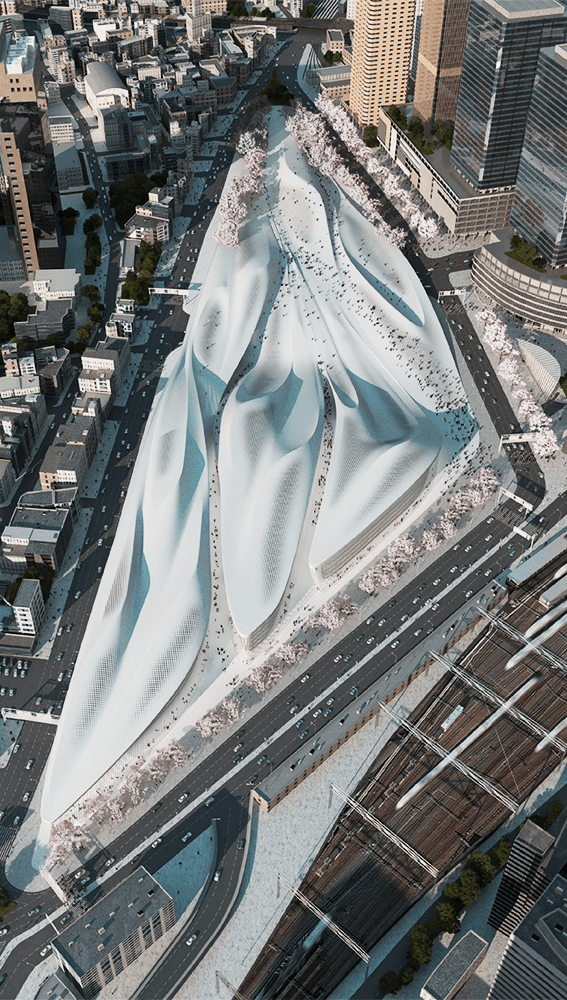
ALISA ANDRASEK
Cloud Osaka
Envisioned as a high-resolution urban interchange, Cloud Osaka embodies Biothing’s approach to complex design synthesis across multiple orders of scale. Due to its central position in the city, a high convergence of users and one of Asia’s densest transportation nodes found in the adjacent JR Osaka Station, the key driver for the project was to understand 2.5 million people traversing the site every day. This is nearly 10 times the number of daily passengers at the busiest airports in the world. Such an extreme volume of pedestrian traffic, compounded by other forms of traffic in the area, warranted choosing computational physics simulation ordinarily used to simulate systems like river flows; indeed, a key driver for the project became the concept of a “river of people”.

Tomas SARACENO
توماس ساراسينو
托马斯·萨拉切诺
トマスサラセーノ
Space elevator / Spark
Black polyester rope, plastic cable ties, metal frame.
Having studied as an architect, Tomas Saraceno incorporates physics, engineering, and aeronautics into his interactive and evolving artistic structures. Using arachnology, or the study of spiders, to create structures that suggest alternative ways of living, he employs tridimensional webs to better understand how unique building blocks create distinct forms. Saraceno places spiders in cubic frames and leaves them to spin webs, rotating the cubes at various intervals to introduce elements of freedom
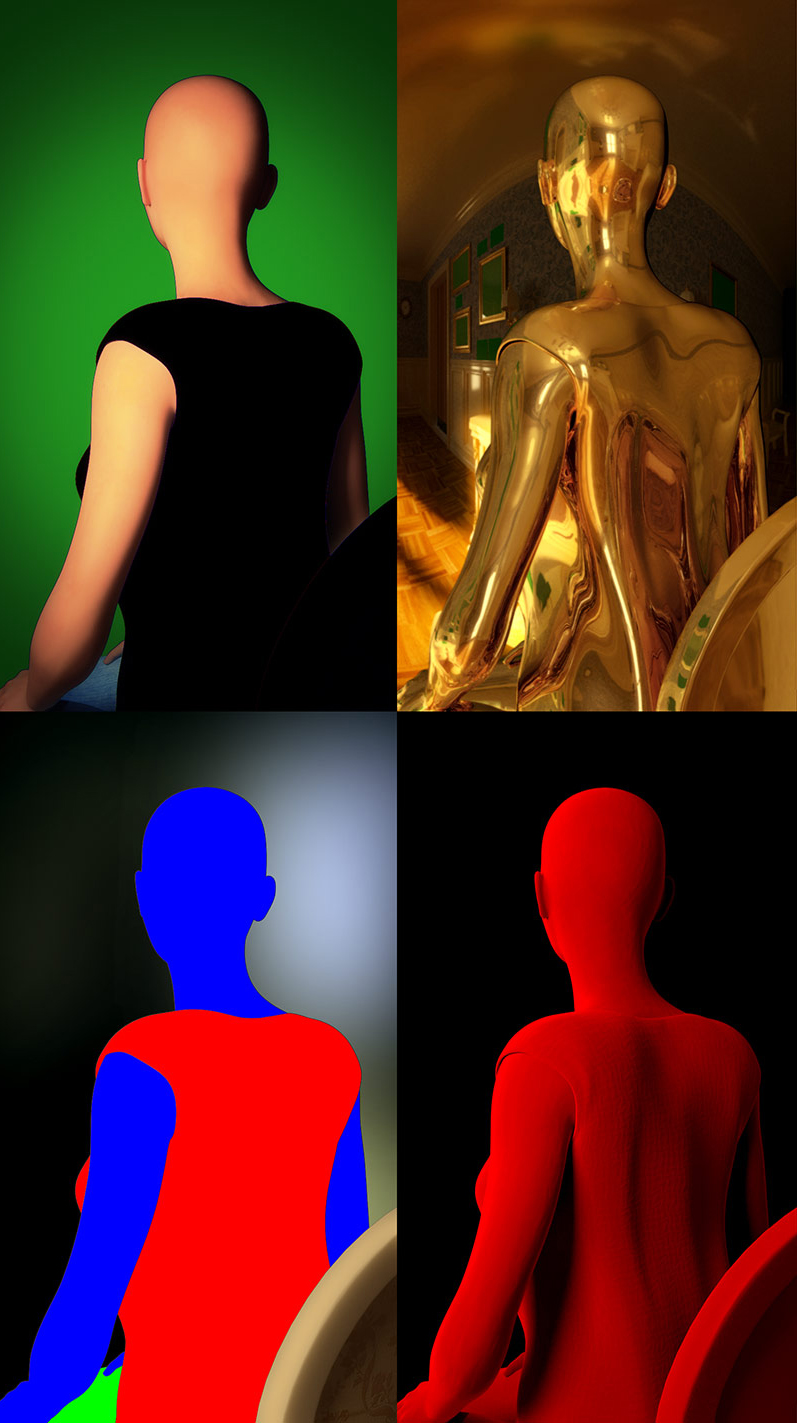
Alan Warburton
Spherical Harmonics
Spherical Harmonics is about the strange power of the CGI image. It’s a fantasy under construction, full of digitally created memories, counterfeit physics and controlled accidents. A place where reality fails because it’s too perfect. Spherical Harmonics sits stylistically at a halfway point between the glossy product displays of Oxford Street and the workhouse construction of Soho’s post production scene.

Peter Jansen
The Olympics
Peter Jansen (1956) studied Physics and Philosophy at the university.For a number of years he worked as a guide, accompanying groups on survival and canoe trips, after which he dedicated his live entirely to the arts. Based on his ideas on transposition and movement the artist Peter Jansen uses shapes of the human body to create energetic spaces.

Ouchhh
AVA_V2 / Particle Physics_Scientific_Installation
Ava; is the surface-volume shape coefficient. The main inspiration comes from monumental experimentations which focused on particle physics. AVA’s design originate from the Buckminster Fuller’s iconic dome structure. It has 360 traceable area from the exterior surface of the dome. Cosmic rays reinterpreted within the concept of AVA and the first version of the performance screened at Paris. AVA is a Commisioned Artwork and designed as a portable installation which can be transportable and positionable at any place.

Refik Anadol
Quantum memories
Quantum Memories is Refik Anadol Studio’s epic scale investigation of the intersection between Google AI Quantum Supremacy experiments, machine learning, and aesthetics of probability. Technological and digital advancements of the past century could as well be defined by the humanity’s eagerness to make machines go to places that humans could not go, including the spaces inside our minds and the non-spaces of our un- or sub-conscious acts. Quantum Memories utilizes the most cutting-edge, Google AI’s publicly available quantum computation research data and algorithms to explore the possibility of a parallel world by processing approximately 200 million nature and landscape images through artificial intelligence. These algorithms allow us to speculate alternative modalities inside the most sophisticated computer available, and create new quantum noise-generated datasets as building blocks of these modalities. The 3D visual piece is accompanied by an audio experience that is also based on quantum noise–generated data, offering an immersive experience that further challenges the notion of mutual exclusivity. The project is both inspired by and a speculation of the Many-Worlds Interpretation in quantum physics – a theory that holds that there are many parallel worlds that exist at the same space and time as our own.

Doug Rosman
Self-contained II
A neural network, trained to see the world as variations of the artist’s body, enacts a process of algorithmic interpretation that contends with a body as a subject of multiplicity. After training on over 30,000 images of the artist, this neural network synthesizes surreal humanoid figures unconstrained by physics, biology and time; figures that are simultaneously one and many. The choice of costumes and the movements performed by the artist to generate the training images were specifically formulated to optimize the legibility of the artist within this computational system. self-contained explores the algorithmic shaping of our bodies, attempting to answer the question: how does one represent themselves in a data set? Building on the first iteration of the series, the synthetic figures in self-contained II proliferate to the point of literally exploding. Through the arc of self-contained II, this body that grows, multiples, and dissolves never ceases to be more than a single body.

ryoichi kurokawa
Unfold
Inspired by the latest discoveries in the field of astrophysics, unfold, an immersive and sensory installation seeks to translate into sounds, images, and vibrations, the phenomena surrounding the formation and evolution of stars and galaxies.

PLAYDEAD
Limbo
Arnt Jensen
File Festival
FILE GAMES
Limbo is a 2D sidescroller, incorporating the physics system Box2D to govern environmental objects and the player character. The player guides an unnamed boy through dangerous environments and traps as he searches for his sister. The developer built the game’s puzzles expecting the player to fail before finding the correct solution. Playdead called the style of play “trial and death“, and used gruesome imagery for the boy’s deaths to steer the player from unworkable solutions.

Martin Hesselmeier and Andreas Muxel
The weight of light
Light, as we usually interpret it, is an element without mass and gravity. For “the weight of light” a physics engine simulates the kinetic forces of a moving object. This mass is projected on a wave shaped structure in virtual space. The moving object is represented as a light particle in physical space. Gravity, mass, density and friction affect velocity and acceleration of these light particles. As the particles movement is based on a simulation, it does not have to adhere to the physical realities we know from everyday life. Therefore the installation goes beyond expected behaviour. Thus the matter of light traverses a reinterpretation of our known reality.

Alyson Shotz
アリソン・ショッツ
Алисон Шоц
Fluid State
Alyson Shotz is an American artist based in Brooklyn, New York. She graduated with a BFA from the Rhode Island School of Design in 1987 and an MFA from the University of Washington in 1991. Alyson Shotz investigates issues of perception and space with sculptures made from a range of synthetic materials such as mirror, glass beads, plastic lenses, thread and steel wire.Karen Rosenberg wrote: “Ms. Shotz evokes natural phenomena with accumulations of beads, pins and other common materials…Often they respond to the challenge of visualizing concepts from theoretical physics (string theory, dark matter).”
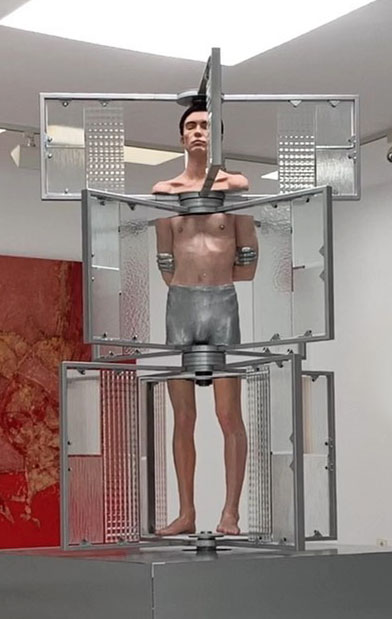
Filip Custic
(ego hiperrealista) + (juguete del viento) =
Custic combines models, costumes and various other objects that inspire him, using them to give form to abstract concepts surrounding humanity and its evolution. Spirituality, religion, relationships and sexuality are all explored through a lens preoccupied with fragmentation, pataphysics, optical balance effects and technological art.
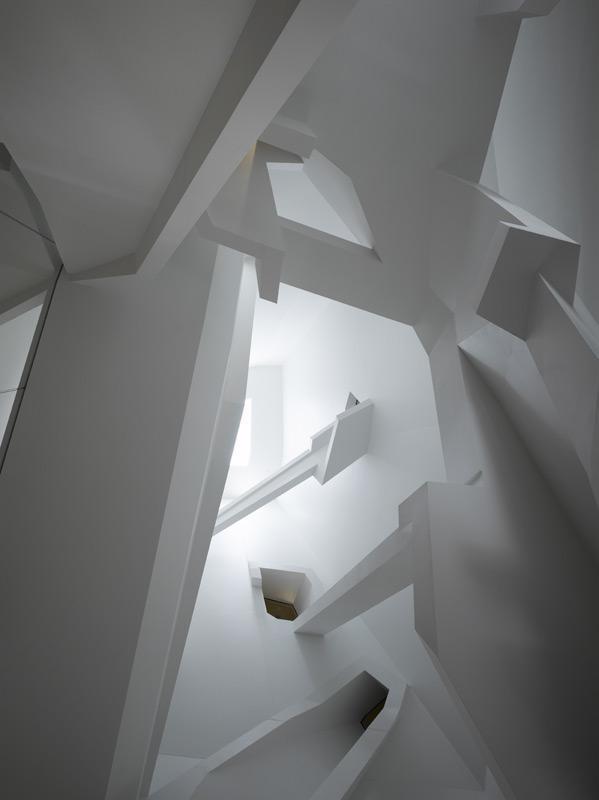
Morphosis Architects
مورفوسيس المعماريين
モーフォシス建築家
모포 건축가
形态结构建筑师
Cahill Center for Astronomy and Astrophysics
The Cahill Center for Astronomy and Astrophysics at Caltech brings together a dozen different scientific groups into one structure. The Cahill Center designed by Morphosis Architects, Inc. conceptually acts as an astronomical instrument. A vertical volume pierces the building, tilting it open to the skies and resulting in an occupiable telescope. The Center also physically and symbolically connects Caltech’s South Campus with the the original complex of Spanish and Mediterranean buildings that comprise the historic North Campus. A series of interior corridors that run north to south serve as stitches, reinforcing the connection and serving to direct circulation.

KAZUMASA NAGAI
The Mind
The Japanese graphic designer, illustrator, and printmaker Kazumasa Nagai (b. April 20, 1929) began his career in abstraction — in masterpieces of graphic design exploring the discoveries and advances in physics and chemistry that scintillated — and sometimes terrified — the popular imagination in the 1960 and 1970s. Three of his works appeared on the cover of LIFE magazine’s Science Library series.

MUHARREM YILDIRIM AND DAVID TINAPPLE
rotary tumble
File Festival
“Rotary Tumble” is an experiment in projection mapping onto a moving tangible object. We start with a freely spinning disc that viewers can touch and spin by hand. With an optical rotary encoder the system detects the exact speed, direction, and position of the spinning disc in real-time. This feedback data is used to drive a physics simulation of tumbling shapes which is then projection mapped back onto the spinning disc itself.

ANDREW HIERONYMI
move
File Festival
MOVE is an interactive installation divided into six distinct modules, JUMP, AVOID, CHASE, THROW, HIDE and COLLECT. Each module offers a single-user interaction, based on a verb corresponding to the action the participant is invited to perform. Each verb corresponds to a common procedure acted out by avatars during videogame play. Each module offers an interaction with abstracted shapes (circles, rectangles) behaving according to simplified rules of physics (collision, friction). Each module is color-coded with consistency, where the color red is used for the graphical element that poses the core challenge. Each module increases difficulty in a similar linear manner.What makes MOVE unusual is that unlike most computer vision or sensor based games like Eye-toy or Dance Dance Revolution, the participant IS the avatar, he is not seeing a representation of herself or an indirect result of her actions on a separate screen but instead interacts directly with the projected graphical constituents of the game. Because those graphical elements are non-representational they do not allow for a projection in a fictional space. The combination of abstracted shapes and direct interaction reinforces in the player the focus on the action itself (JUMP, AVOID, CHASE, THROW, HIDE or COLLECT) instead of an ulterior goal.

LECH MAJEWSKI
The Garden of Earthly Delights
Based on his own novel “Metaphysics”, Lech Wajewski’s film is an erotic treatise on art, love and death. When British art historian Claudine learns that her cancer is terminal, she abandons caution and takes her lover, Chris, on an extraordinary journey to Venice, where their passion finds fulfillment in the fantastic paintings of Hieronymus Bosch. Videotaping their trip, Claudine intends to leave Chris a haunting record of their emotional and spiritual discoveries.

HIRO YAMAGATA
هيرو ياماغاتا
ヒロ·ヤマガタ
Хиро Ямагата
Quantum Field X3
Hiro Yamagata focuses on the technique as well as on physics. By using lasers as a mean of expression, he searches for the possibilities of creation , constantly looking for a new technique to experiment. Consequently, his aim is science itself and his creations have the goal to present a new technique which is often futuristic.
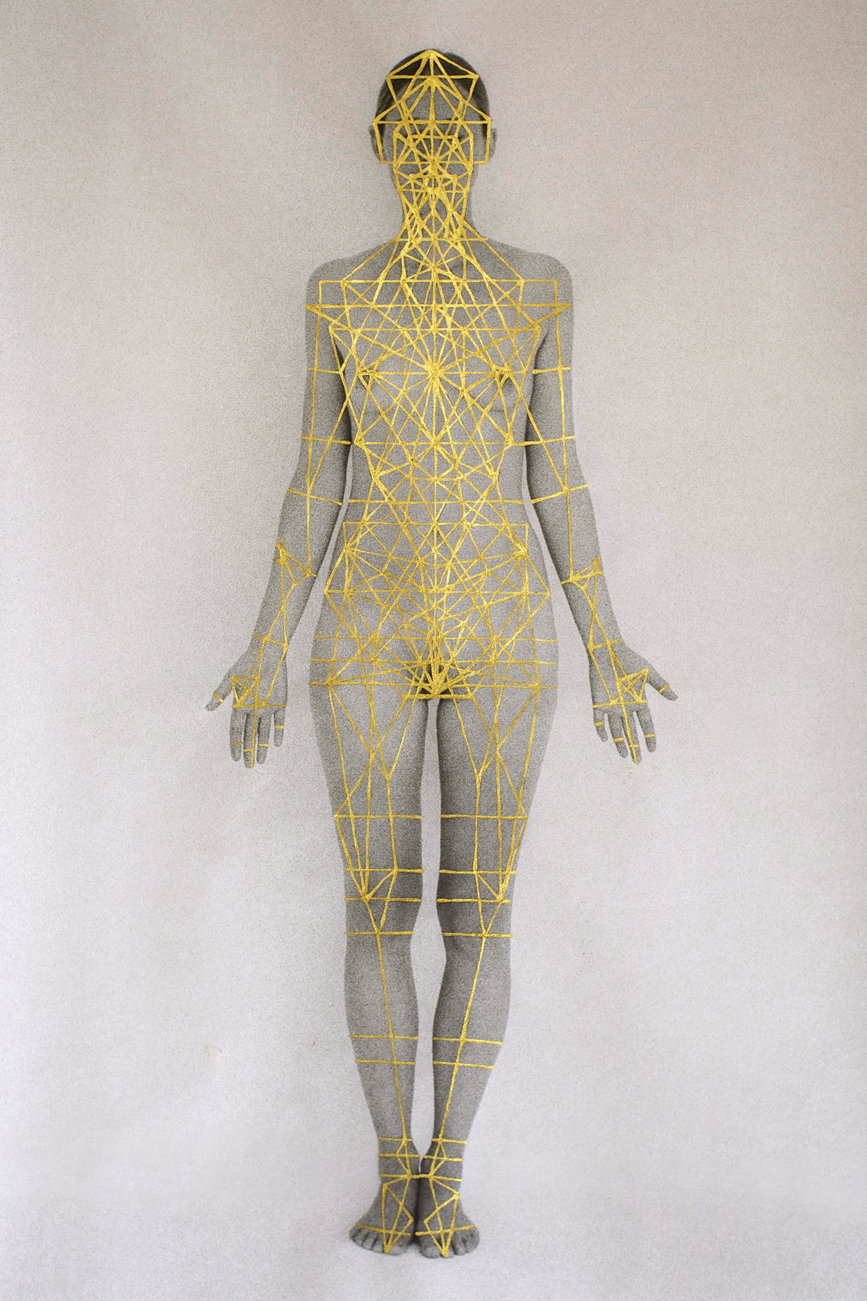
rachel garrard
Body Systems I
British-born artist Rachel Garrard creates a range of multi-disciplinary work that explores the great unknown, looking to quantum physics and other theories of the universe for inspiration and guidance. Both her video performance pieces and works on paper capture, despite their earthly limitations, the infinite nature of life on this planet and beyond. In a personal statement on her blog, the artist explains “that exploring the outer reaches of the universe can be similar to exploring the inner reaches of the human psyche and that both are governed by the same forces.

ALYSON SHOTZ
アリソン・ショッツ
Алисон Шоц
Alyson Shotz’s sculptures perk up a decades-old post-Minimalist idiom with a dash of pop science. Ms. Shotz evokes natural phenomena with accumulations of beads, pins and other common materials. She isn’t alone in this — Tara Donovan comes to mind — but her creations have a geekier, less arbitrary aspect. Often they respond to the challenge of visualizing concepts from theoretical physics[…]
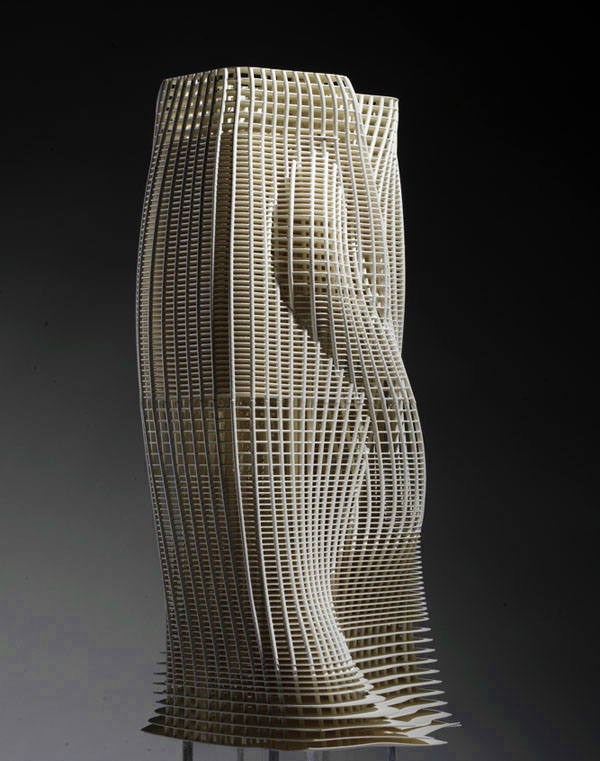
OCEAN DESIGN RESEARCH
World center
Blending computer-assisted design and experimentation with physics, the collective implements a biological paradigm to develop their morpho-ecological design approach to the architectural project. They are able to do this thanks to the computer-generated design methods they have developed for integrating ecological, topological and structural data.more…

JONTY HURWITZ
Anamorphic sculpture
London-based artist Jonty Hurwitz creates ‘Anamorphic Sculptures’ which only reveal themselves once facing a reflective cylinder. Hurwitz took an engineering degree in Johannesburg where he discovered the fine line between art and science. He has lived in England for many years, working in the online industry though he quietly levitated into the world of art inspired by a need to make ‘something real’. Hurwitz discovered that he could use science as an artistic paintbrush. Each of his sculptures is a study on the physics of how we perceive space and is the stroke of over 1 billion calculations and algorithms.
.

Marcos Novak
Turbulent Topologies
This exhibition explores turbulence as both a formal principle and as a condition of the global metropolis. Through a variety of means, both visible and invisible, it examines the turbulent topologies of mixed layers and crossed currents, hidden links and sudden connections, flow networks and perturbed stratifications. Using both high and low technologies, it proposes a continuum between actual, virtual, and transactive space, form, and inhabitation. Drawing upon diverse fields such as particle physics and biology, logic and geology, and lived histories as they are alternately formed by and trapped in the webs of culture, it offers a series of formal propositions in response to the critical acceptance of turbulence as a condition of twenty-first century life.
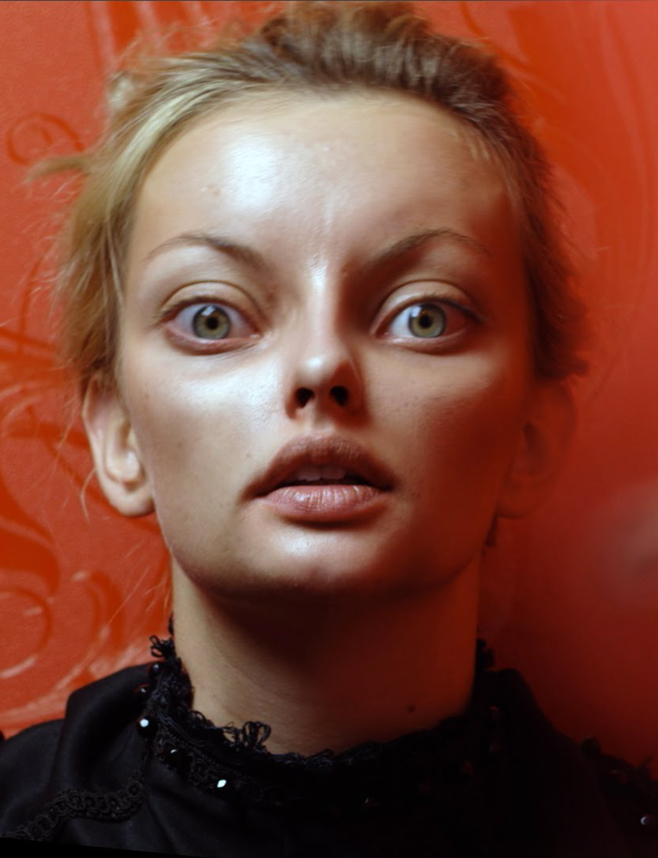
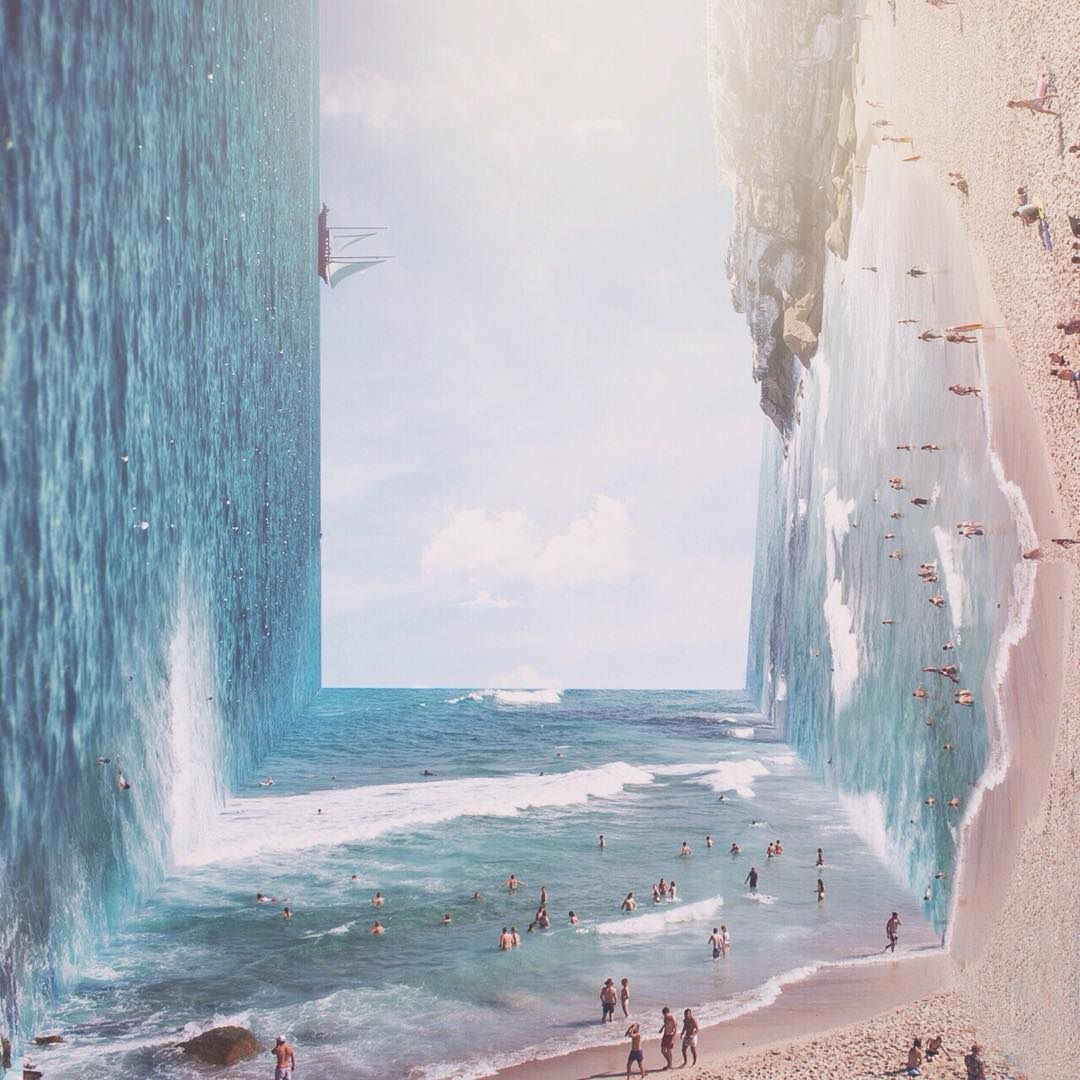
jati putra
Jati Putra Pratama turns landscape photos into surreal works of art by contorting the scenes to include unusual angles. The Jakarta, Indonesia, graphic designer made waves on Reddit after posting one of his pieces, spawning a flood of copy-cat work, and even a tutorial. Many online commentators write that Pratama’s work is reminiscent of the physics-defying scenes from the hit-film Inception, but this isn’t Pratama’s only style: his Instagram features more traditional (if there can be such a thing) surreal photos as well.
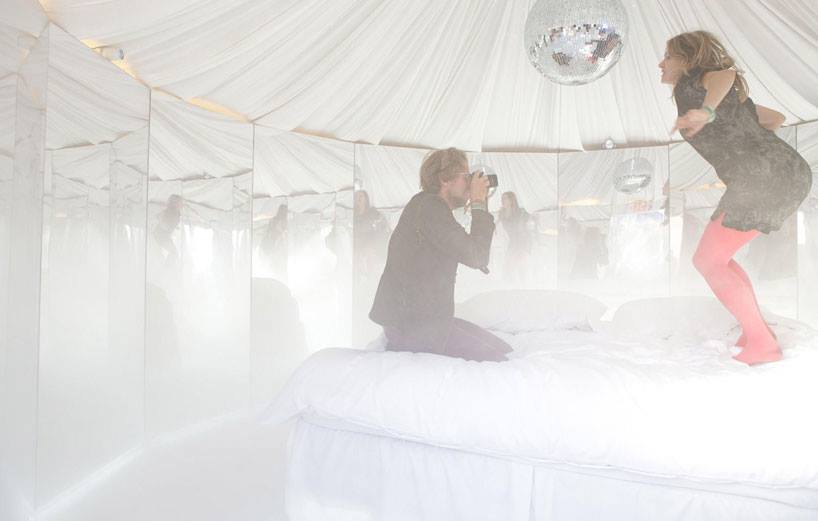
URS FISCHER
Урс Фишер
nomadic art tent
The nomadic sculpture that Urs Fischer created for Station to Station is something of a steamy interior dreamscape, a glittery, shimmering vision that hypnotizes with lights and textures that both welcome and disorient. In the center of the piece is a plush Hasten’s bed on which viewers lie surrounded on all sides by mirrors and cloud-like smoke. A disco ball rotates above. Is this a place for disco naps? Or is it a glamorous fantasy of decadence and visual riches? Spend some time, look at yourself in the many reflective surfaces, and feel the bedding against your skin and decide for yourself. Dreamy as it is, this space is grounded in the real world and governed by the laws of physics. This place seems like a fantasy, but it is entirely real. As one critic noted of an earlier Fischer work:In a world increasingly defined by virtual realities and digital imaging, is the creative mastery of hand manufacture merely a quaint artistic throwback — nostalgia for a lost cultural past? Is this sculpture a memorial? Given today’s ubiquitous special effects wizardry, shouldn’t art clasp technology to its bosom? There’s nothing virtual about the softness of the bed, nothing digital about the gleam of those lights or the mist surrounding you. Take off your shoes. Climb inside. This is real life.

JON MCCORMACK
Джон Маккормак
Eden – an evolutionary sonic ecosystem
Eden is an interactive, self-generating, artificial ecosystem. A cellular world is populated by collections of evolving virtual creatures. These creatures move about their environment, making and listening to sounds, foraging for food, encountering predators and possibly mating with each other. Over time, creatures evolve to fit their landscape. Eden has four seasons per year and each year lasts 600 Eden days. One Eden year passes by in about fifteen minutes of real time. A simple physics dictates only three basic types of matter in the Eden world: rocks, biomass and sonic creatures.

Joon Y. Moon
Augmented Shadow
File Festival
Augmented Shadow is a design experiment producing an artificial shadow effect through the use of tangible objects, blocks, on a displayable tabletop interface. Its goal is to offer a new type of user-experience. The project plays on the fact that shadows present distorted silhouettes depending on the light. Augmented Shadows take the distortion effect into the realm of fantasy. Shadows display below the objects according to the physics of the real world. However, the shadows themselves transform the objects into houses, occupied by shadow creatures. By moving the blocks around the table the user sets off series of reactions within this new fantasy ecosystem. In this installation, the shadows exist both in a real and a virtual environment simultaneously. It thus brings augmented reality to the tabletop by way of a tangible interface. The shadow is an interface metaphor connecting the virtual world and users. Second, the unexpected user experience results from manipulating the users’ visual perceptions, expectations, and imagination to inspire re-perception and new understanding. Therefore, users can play with the shadows lying on the boundary between the real, virtual, and fantasy. Augmented Shadow utilizes this unique interface metaphor for interactive storytelling. Maximizing the magical amusement of AR, it is embedding an ecosystem where imaginary objects and organic beings co-exist while each of them influences on each other’s life-cycle, even though it is not in use by users. Light and shadow play critical roles in this world’s functions causing chain reactions between virtual people, trees, birds, and houses. A set of tangible blocks allows users to participate in the ecosystem. Users can influence on the system by playing with the blocks or observe the changes of the shadows as if kids were playing with an ant farm.

MICHAEL GUIDETTI
Bounce Room 1
“The digital projection represented as three red, green, and blue spherical lights; and the painted environment as five flat planes receding in perspective. That’s about as far as I could boil them down to. Separately they are elementary and flat, but when they come together, the simulated light and physics of the spheres bouncing around in the space becomes illusionistic.” Michael Guidetti

LUCAS WERTHEIN
Lucas Werthein & Jason Aston
The Boom Shakalaka
As Rube Goldberg showed us in his now notorious cartoons depicting complex devices performing the simplest of tasks in the most roundabout ways, precision, timing, and creativity are tantamount to making such a machine functional and enjoyable. Invoking a popular physics engine, “Boom Shakalaka” creates a real time world with real time physics that portrays obstacles faced in the real world.
FILE FESTIVAL